This tutorial will take you through the sequence of events as a nerve transmits an impulse to another cell.
You can navigate through this tutorial using the buttons at the top of the screen.
The tutorial will ask you questions. Click on your chosen answer to see feedback; click the answer again to make the feedback disappear. When you're finished with one page, click the navigation button for the next page to move ahead.
Have fun! Click on button '1' to see the first page of the tutorial.
Page 1
You should already know the basics of how a nerve fires. If you don't, you might want to look at the nerve firing tutorial first.
Sometimes the nerve that fires isn't the cell that actually responds. Right now, for instance, you're reading - nerves in your eyes and brain are firing - but your fingers may be the organs responding, as you hit computer keys or take notes.
How did the nerve firing in one part of your body make a different part of your body react?

The answer is that a neuron can pass a message to another cell. The place where the two cells come together is called the synapse. The cell before the synapse, bringing the message, is the presynaptic cell. The cell after the synapse, receiving the message, is the postsynaptic cell.
Page 2
Let's look at this closer.
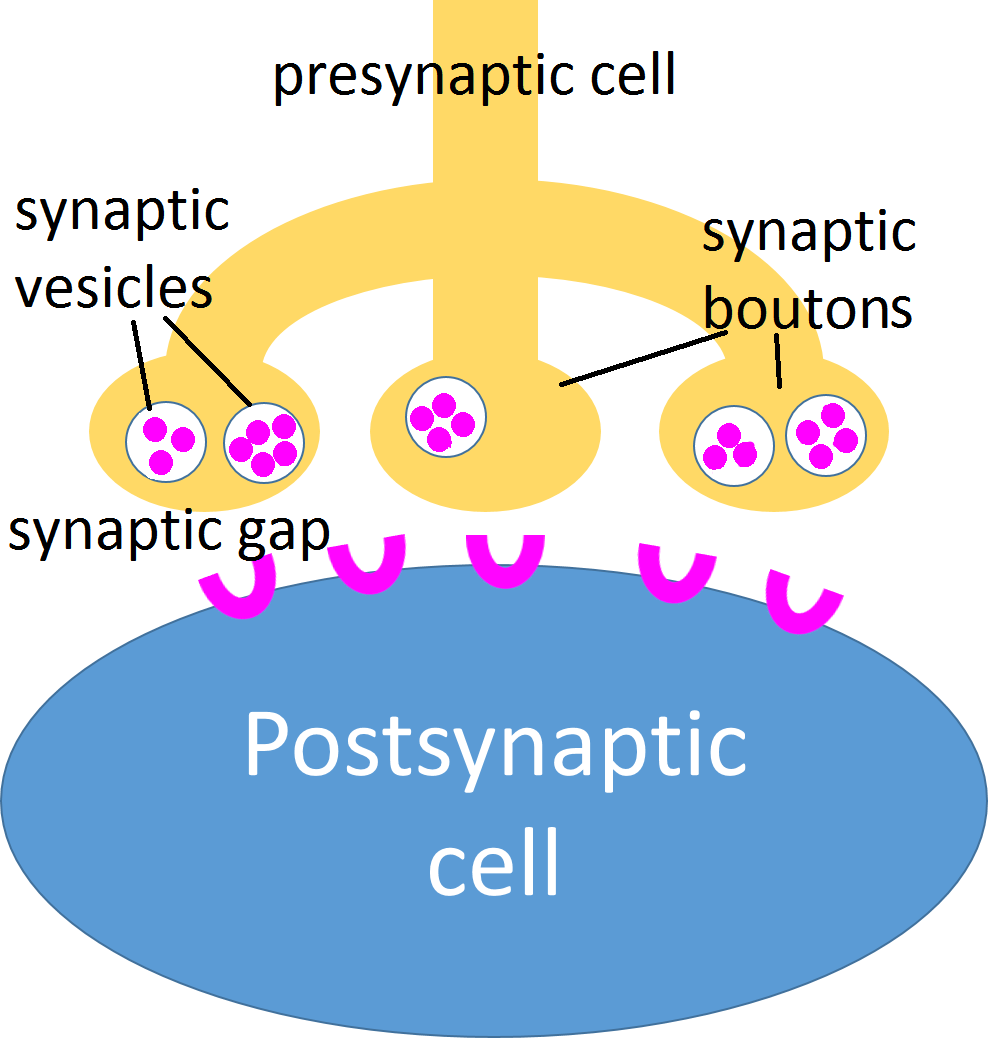
When the presynaptic cell fires, those synaptic vesicles will float to the edge of the bouton and break open, releasing their contents into the space between the cells - the synaptic gap.
What do the vesicles release? Molecules of neurotransmitters.
Neurotransmitter - a chemical secreted by a neuron when it fires.

image modified from Pixabay free images
You can think of it like a skunk ... the neuron releases a chemical, and when that chemical hits postsynaptic cells, they react. The same way you would react when the skunk smell hits your nose.
Page 3
Now let's check out the postsynaptic cell. See the little cups on its surface? These represent receptors - proteins with a binding site that some chemicals can fit into but other chemicals cannot fit into.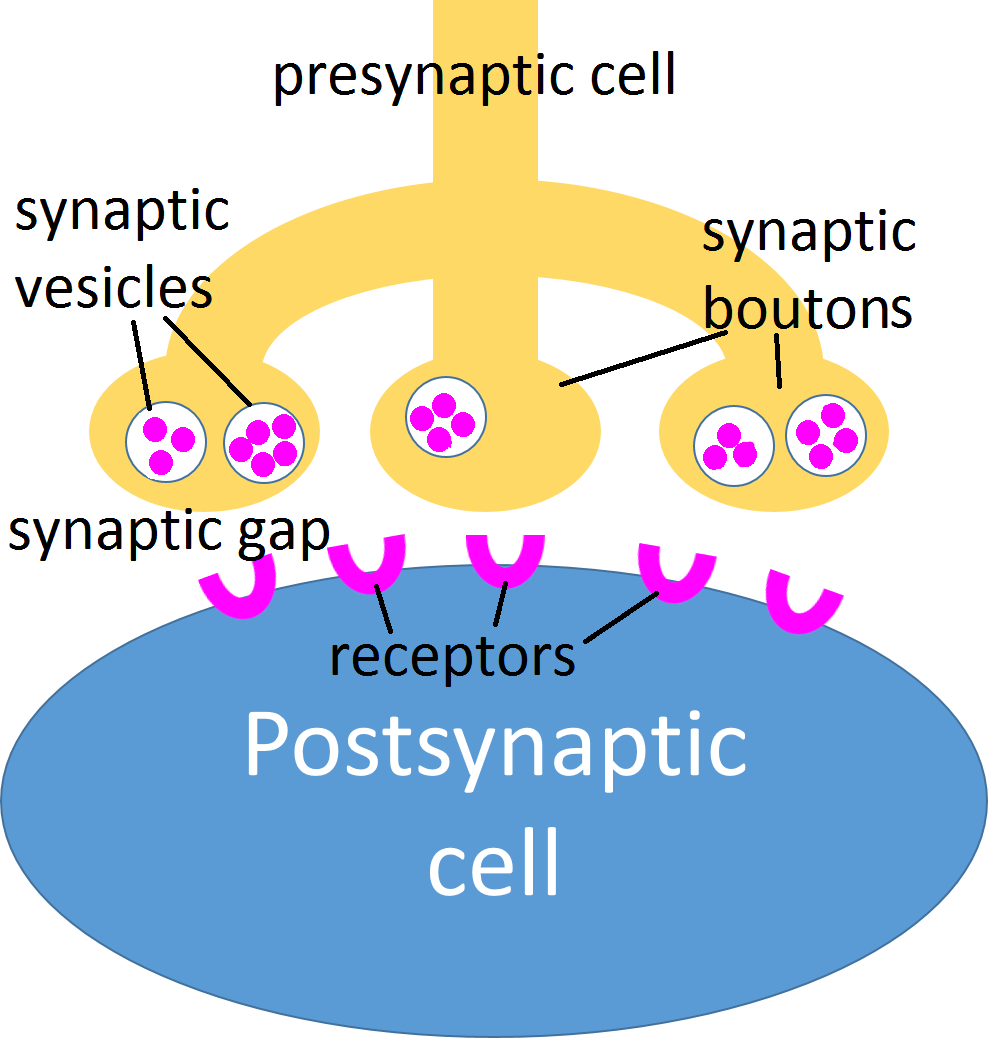
Now we have all the elements needed for a chemical synapse. It's called a chemical synapse because the synaptic vesicles are going to release a chemical - the neurotransmitter.
There are lots of different kinds of neurotransmitters; not all nerves release the same kind. But there are some things that are true for all the different neurotransmitters.
1. They are released from presynaptic cells
2. They diffuse across the synaptic gap
3. They attach to receptors on postsynaptic cells
4. Then they have an effect on the postsynaptic cells
5. The effect they have depends on how the receptors they attach to react. Some receptors will open ion channels, some will activate enzymes, some might even tell the cell to make proteins or divide.
6. For the postsynaptic cell to stop responding, the neurotransmitters must be removed from the receptors. In some synapses, the neurotransmitter is destroyed by an enzyme. In some synapses, the neurotransmitter is picked up by a transport protein and carried back to the presynaptic cell, to be used again.
Page 4
Now the presynaptic cell has been stimulated, and the neurotransmitter molecules have been released!
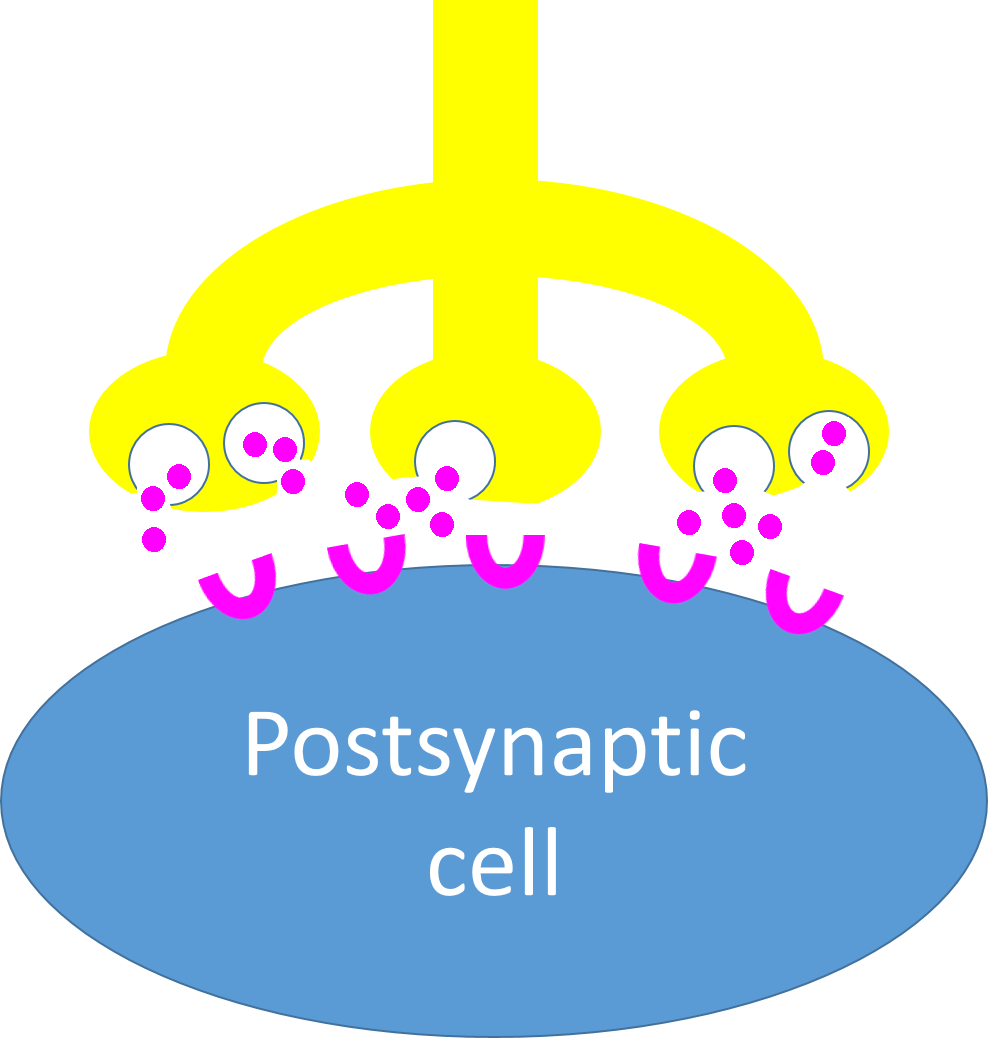
The molecules bounce around at random in the synaptic gap, until they happen to hit receptors. Then they stick, and cause the receptors to change shape.

On-off switch by Jason Zack. Used under a Creative Commons license via wikimedia
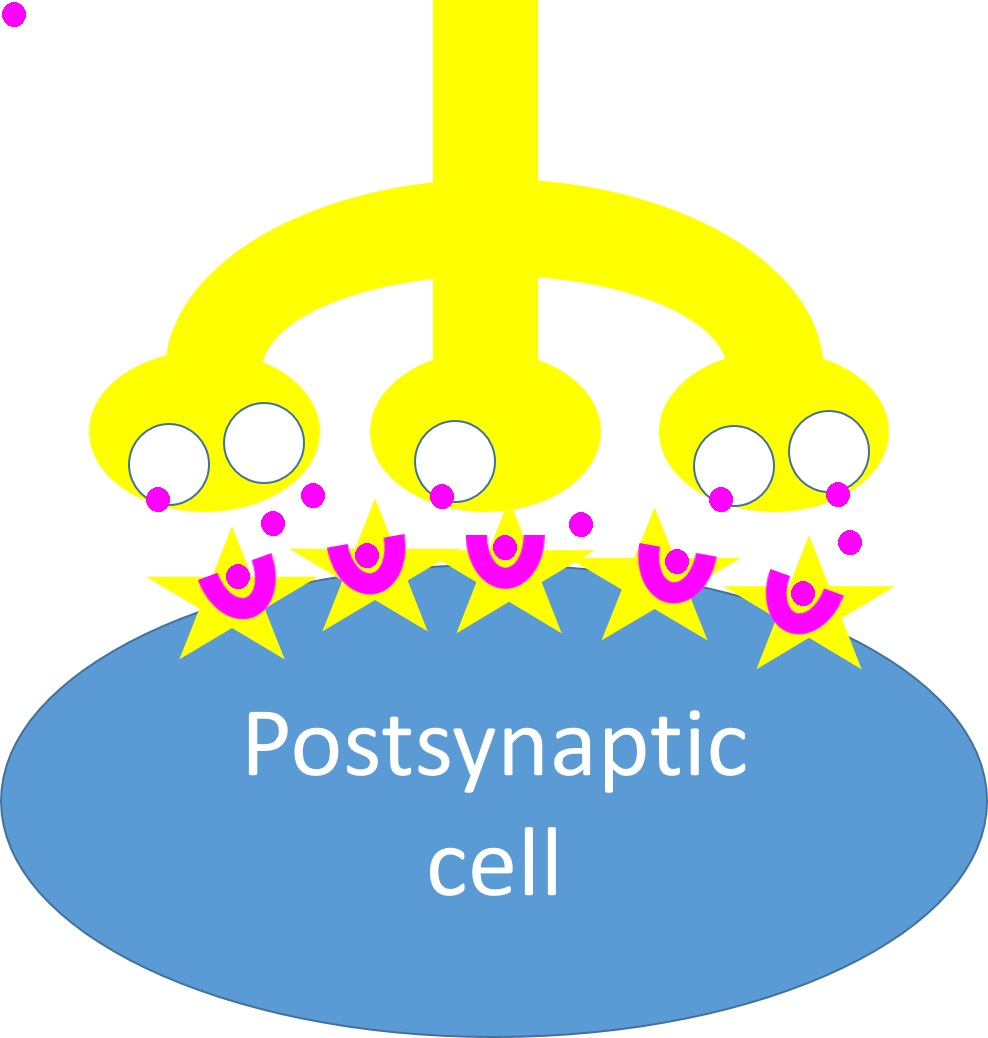
On some postsynaptic cells, the receptors are actually ion channels, so when the neurotransmitter attaches to the receptor it can open or close those channels.
What would happen if this neurotransmitter attached to receptors that were Na+ channels, and opened them?
Na+ would enter the postsynaptic cell and make it more positive
Page 5
Create a flow chart! Choose the terms that fill in the blanks.

When a neurotransmitter attaches to receptors and those receptors then open Na+ channels, Na+ leaves / enters the cell. As a result, the cell's charge becomes more / less negative. The cell has become hyperpolarized / hypopolarized, and its charge is closer to / further from threshold. The cell is more / less likely to fire.
The change in cell charge caused by a neurotransmitter is called a postsynaptic potential, abbreviated PSP. For this neurotransmitter, what should we call it? Inhibitory, IPSP / Excitatory, EPSP
Lots of neurotransmitters are excitatory.
For instance, the neurotransmitter Acetylcholine excites your skeletal muscle cells by opening their Na+ channels (Acetylcholine actually opens both Na+ and K+ channels on skeletal muscles, but there is so much Na+ flowing into the cell that it more than cancels out any K+ that leaves).
If predicting how ion channels affect cell firing confused you at all, you can click on the 'ion diffusion' button at the top for some more practice with that concept.
Page 6
What would happen if a neurotransmitter opened only K+ channels instead of Na+ ones? Choose the right terms to fill in the blanks.

When a neurotransmitter attaches to a receptor that only opens K+ channels, K+ leaves / enters the cell. As a result, the cell's charge becomes more / less negative: we would say the cell was hyperpolarized / hypopolarized.
The cell's charge is now closer to / further from threshold, so the cell is more / less likely to fire.
We would describe the postsynaptic potential caused by this neurotransmitter as inhibitory, IPSP / excitatory, EPSP.
If predicting how ion channels affect cell firing confused you at all, you can click on the 'ion diffusion' button at the top for some more practice with that concept.
Page 7
Good work!
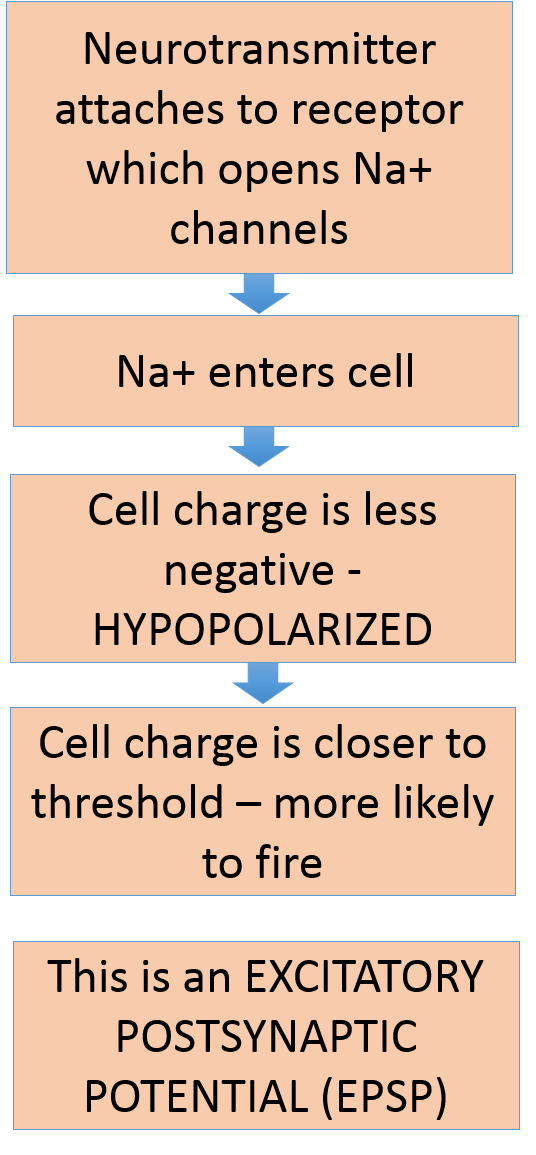

Takehome message:
The same neurotransmitter can excite one cell and inhibit a different cell, depending on which ion channels the receptor opens.
Remember the neurotransmitter Acetylcholine, that excites your skeletal muscles by opening Na+ channels? The same Acetylcholine will inhibit your heart muscles by opening their K+ channels.
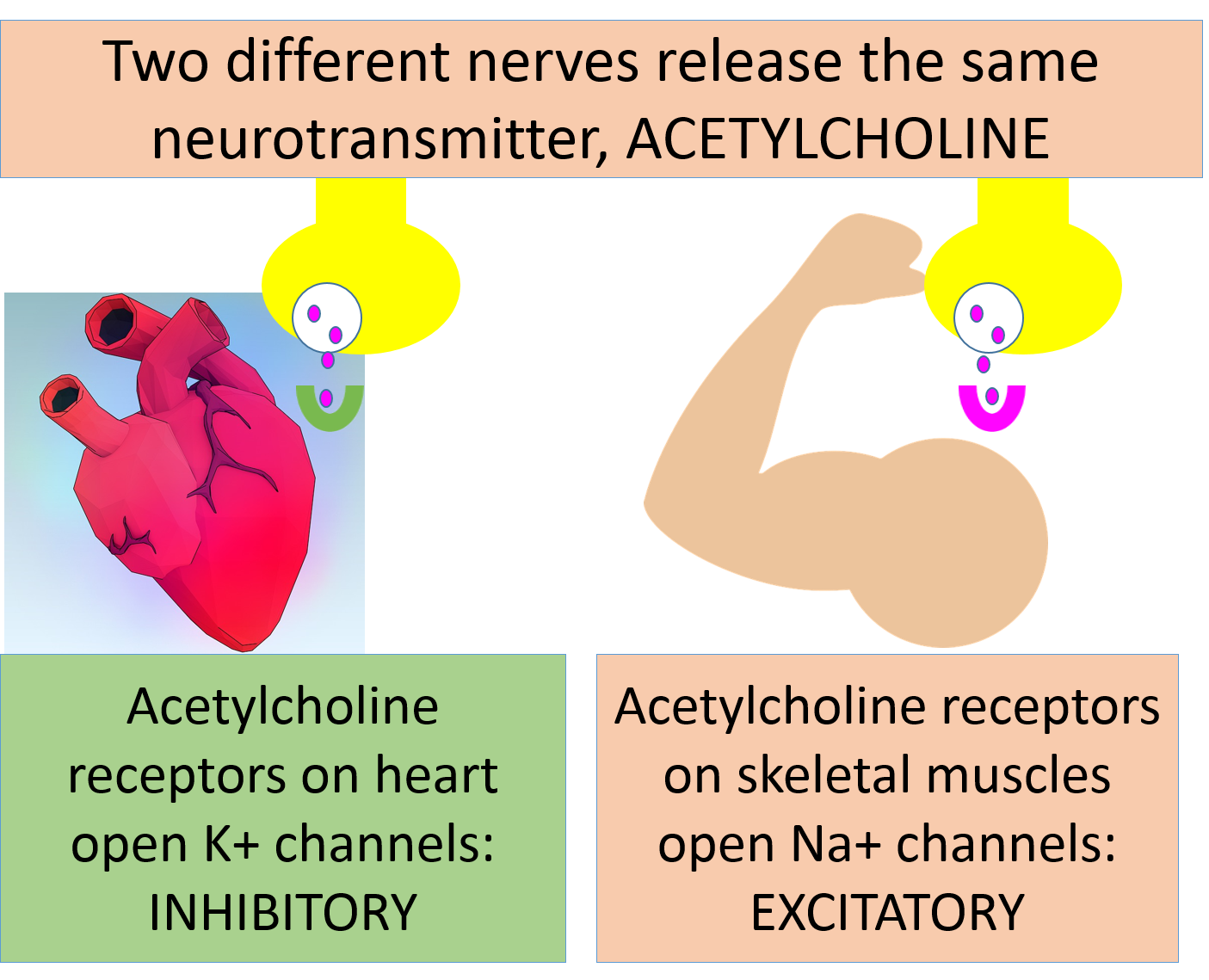
heart and muscle images free from Pixabay
Page 8
We've been talking about neurotransmitter receptors that open ion channels, making the cell more or less likely to fire. In fact, these receptors often are ion channels. That's as simple as it can get!
Sometimes, though, the receptors and the ion channels are two different molecules. They may even be separated from each other. After all, the receptors have to be right at the synapse, where they can catch neurotransmitters. The ion channels have to be where they can interact with the ions outside the cell.
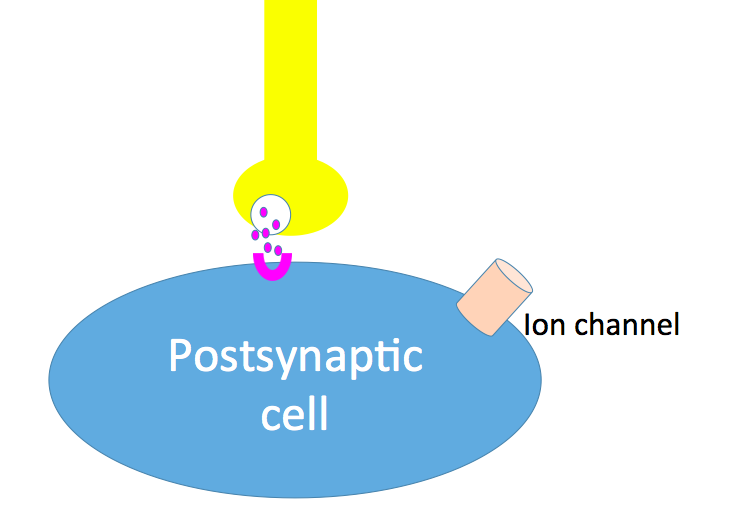
The answer: it uses G-proteins.
This isn't as weird as you might think. Remember we were thinking of the receptor as a switch? You have switches all over your house that aren't part of the thing they turn on. Like a light switch on the wall - when you turn it on, the light bulb in the ceiling lights up. Something had to run along the wires from that switch up to the light bulb to make the bulb light up.
Likewise on the surface of your cell, one of the G-proteins runs between the receptor and the thing it is activating. This is called a
G-protein mechanism


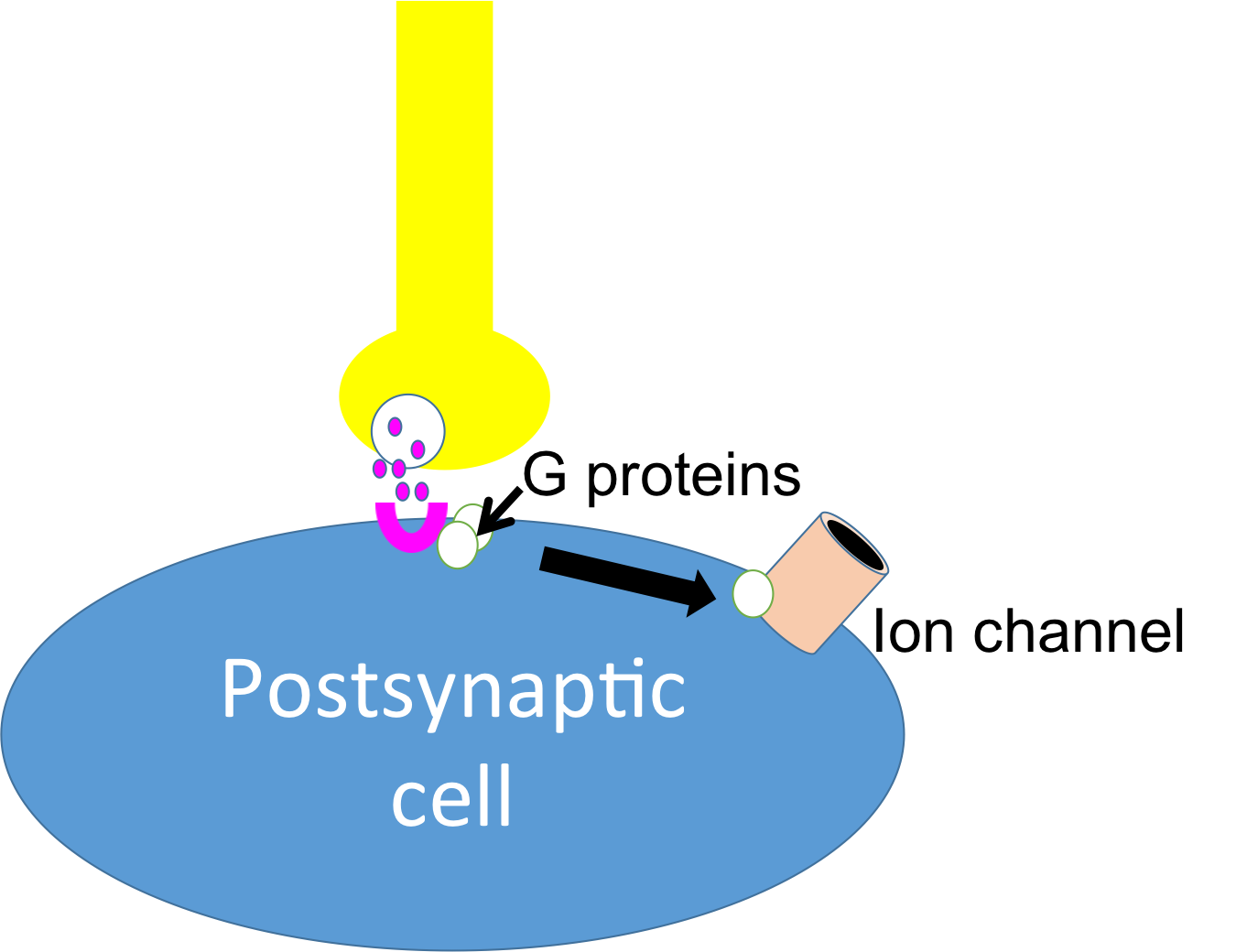
In this cartoon, you can see that the receptor has a group of three small G-proteins beside it; when a neurotransmitter attaches to the receptor, one of the G-proteins dissociates from the group and begins to move toward the ion channel; in the third panel, the G-protein has reached the ion channel and made it open.
G-proteins, just like simpler receptors, can affect different ion channels, open ion channels, or close ion channels. When acetylcholine makes your heart slow down, for instance, it uses a G-protein mechanism that opens K+ channels.
Page 9
How a neurotransmitter can affect a cell depends on what the receptor is able to do.
Some receptors are ion channels, and they can open or close.
Some receptors aren't ion channels, but they can send G-proteins over to ion channels and open or close the channels that way.
This is how neurotransmitter receptors can excite or inhibit cells.
But some receptors don't affect cell firing at all! They make cells do other things like manufacture proteins, or release stored food, or pick up molecules from the blood and burn them for energy.
There's nothing on the cell's surface that can do these things; they require the organelles down inside the cell to get busy. But the receptor is stuck out on the cell surface, and so are the G-proteins. How can the receptor send the message down into the cell?
The answer: second messengers.
Page 10
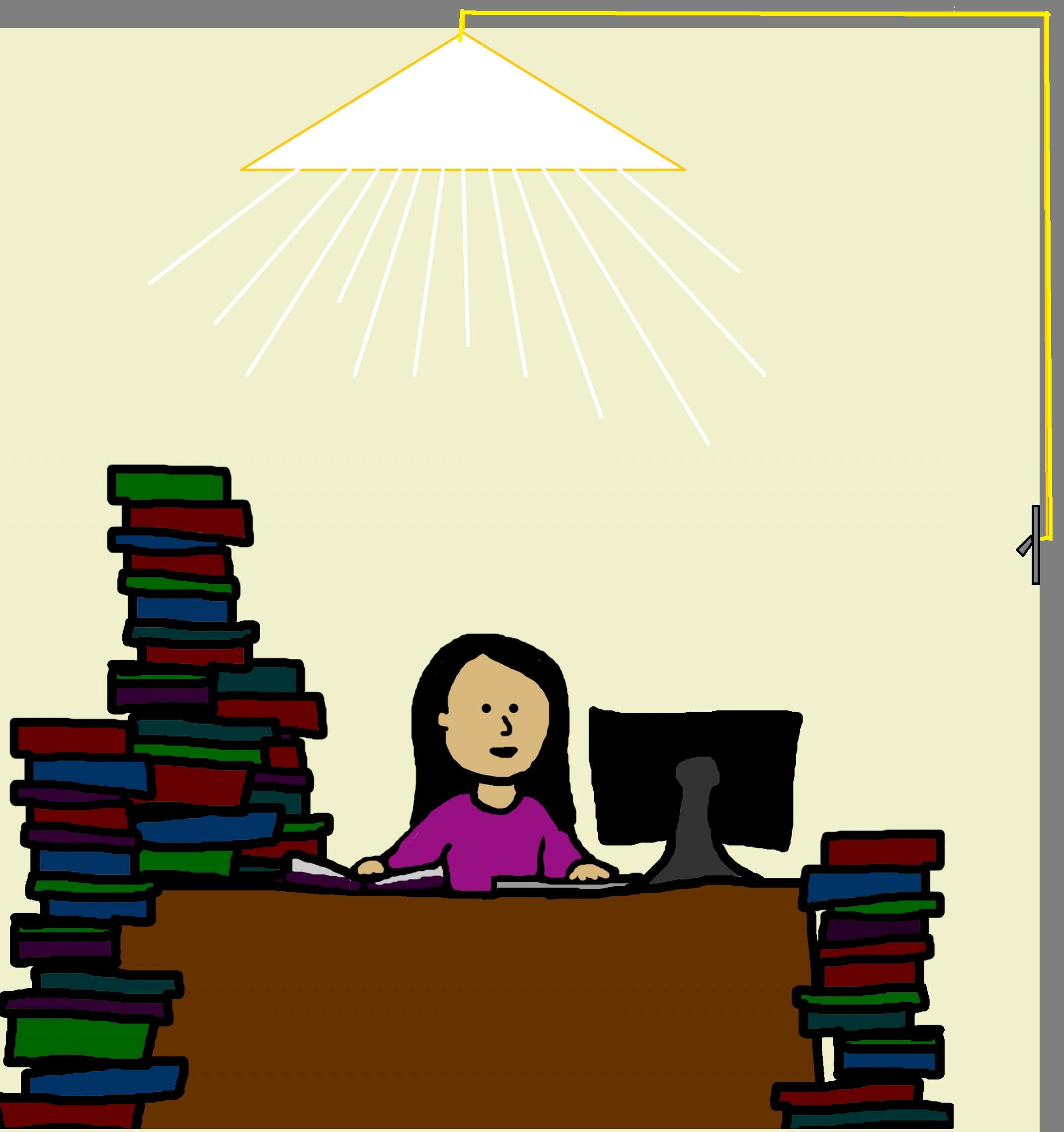
Modified from "Woman studying cartoon", Public Domain Pictures
How were you able to do that? You're not anywhere near the light, or the switch, or the wires in the wall, but the light switch still made you do something you weren't doing before. It was because the light from the light bulb came down to where you are.
Now imagine your room as a cell. It has a receptor on the membrane, and a G-protein that can run along the membrane, and all sorts of other things on the membrane; but it needs to make something happen down in the middle of the cell, where you are. The G-protein needs to run to something in the membrane that will send a second messenger down into the cell, just the way your light bulb sent light down to you so you could study. Only instead of light, your cell's second messenger systems send chemicals.
The second messenger system looks a lot like any other G-protein mechanism, with a receptor and G-proteins beside it. The difference is, this receptor doesn't send the G-protein to an ion channel. It sends the G-protein to an enzyme that is able to make or destroy small molecules called second messengers.


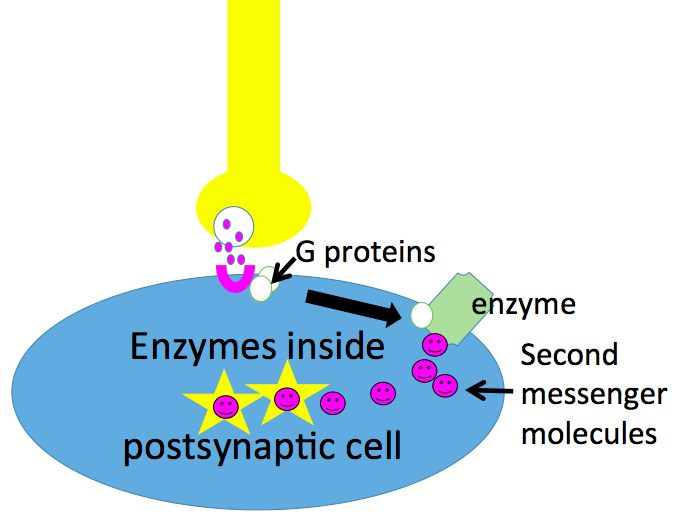
The receptor has changed the amount of second messengers inside the cell, and thereby controlled cell functions - just the way someone could control your studying by turning the light switch on or off.
Page 11
You're done with the introduction to neurotransmitters. Do you think you remember all of it? Here are some true/false questions to test yourself.
All neurotransmitters open ion channels True /
False
The same neurotransmitter can have completely different effects on different cells. True /
False
A neurotransmitter can only affect a cell with a receptor it can attach to True /
False
The way a neurotransmitter affects a cell depends on the molecular structure of the neurotransmitter True /
False
The way a neurotransmitter affects a cell depends on the receptor True /
False
All neurotransmitter receptors work by G-protein mechanisms True /
False
A second messenger system is a kind of G-protein mechanism True /
False
G-proteins can affect ion channels, or they can control enzymes in the cell membrane True /
False
G-proteins can go down inside the cell and activate enzymes True /
False
Second messengers work by stimulating the receptors True /
False
If you can answer these, you probably know the systems! Try drawing them out from memory, and teaching them to someone else.
ion diffusion pg 1
Let's review ion diffusion and how it relates to nerve firing.
Two factors affect ion diffusion into or out of a nerve cell. They are:
concentration gradient
andmembrane permeability

In this picture of a cell in the blood, there are many more ions outside the cell than inside. Which way will the ions naturally tend to diffuse?
higher concentration in the blood: ions will tend to diffuse from blood into cell
higher concentration in the blood: ions will tend to diffuse from cell into blood
lower concentration in the blood: ions will tend to diffuse from blood into cell
lower concentration in the blood: ions will tend to diffuse from cell into blood
ion diffusion pg 2
Good work! The ion concentration outside this cell is higher than the concentration inside, so the ions would naturally tend to diffuse into the cell -- IF they could get through the membrane! Ions often have a hard time getting through cell membranes, because the membrane is made of lipids and ions are charged particles - they don't dissolve in lipids. So to get in, ions must diffuse through proteins called ion channels. The more ion channels are open, the more permeable the membrane is to that ion: that is, it will let the ion through.
Now the cell has opened its ion channels, the ions can diffuse between the cell and blood.

If this ion were positively charged, how would it affect the cell's charge when it diffused in through the channels?
The cell's charge would become more negative
The cell would become more positive
What if this ion were negatively charged? How would it affect the cell's charge then?
ion diffusion pg 3

In this picture of a cell in the blood, there are many more ions within the cell than outside it. Which way will the ions naturally tend to diffuse?
higher concentration in the blood: ions will tend to diffuse from blood into cell
higher concentration in the blood: ions will tend to diffuse from cell into blood
lower concentration in the blood: ions will tend to diffuse from blood into cell
lower concentration in the blood: ions will tend to diffuse from cell into blood
ion diffusion pg 4

Now the cell has opened ion channels so that the ion can actually move between the cell and the blood. If this ion were positively charged, how would it affect the cell's charge when it diffused through the channels?
The cell's charge would become more negative
The cell would become more positive
What if this ion were negatively charged? How would it affect the cell's charge then?
ion diffusion pg 5
Now try and put it together with this more complicated cell diagram.

This is a more realistic situation, involving four different ions. The cell contains high concentrations of the blue and green ions, and the blood contains higher concentrations of the red and purple ones.
The blue ion is negatively charged. What will happen if the cell opens ion channels for the blue ion?
Blue ions will enter the cell, making the cell more negative
Blue ions will leave the cell, making the cell more positive
Blue ions will enter the cell, making it more positive
What if ion channels for the positively charged purple ion opened?
Purple ions would enter the cell, making it more negative
Purple ions would leave the cell, making it more negative
Purple ions would enter the cell, making it more positive
The green ion is positively charged and so is the red ion. If you want to make this cell more negatively charged, would you open channels for the red ion or the green one?
ion diffusion page 6
CONCENTRATION GRADIENT tells you which way it will move, in or out
PERMEABILITY tells you whether it can get through the membrane
CHARGE tells you whether it is positive or negative
Have fun with the rest of the tutorial! Choose the page you want to go to from the buttons in the header.
flow chart 7
Sources used in creating this tutorial include:
Fox, S. I., 2001. Human Physiology. McGraw-Hill.
Porth, C., 2002. Pathophysiology. 6th Edition. Lippincott, Philadelphia, Pa.